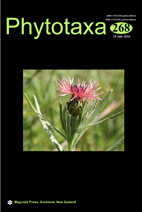Abstract
A new species, from the montane region of Los Tuxtlas (state of Veracruz, Mexico), Ceratozamia subroseophylla, is proposed in accordance with the integrative taxonomy framework and through application of the taxonomic circle rationale. Our identification of this new species is the result of a thorough re-evaluation of four formerly described Ceratozamia species, namely: (1) C. miqueliana, with which it overlaps geographically; (2) C. mexicana; (3) C. robusta, which has also been previously seen as morphologically similar to C. miqueliana; and (4) C. brevifrons, which was at the center of a controversy concerning the morphological and geographic limits when compared to C. mexicana. Even though there are morphometric affinities of C. subroseophylla with this set of species, there are apomorphies in qualitative morphological characters and diagnostic nucleotidic variants established through character-based DNA barcoding to allow the recognition of this new species. The implications that our integrative taxonomy-based assessment of systematic diversity in Ceratozamia species from Veracruz have for evaluating the overall taxonomic status of the genus are discussed.

